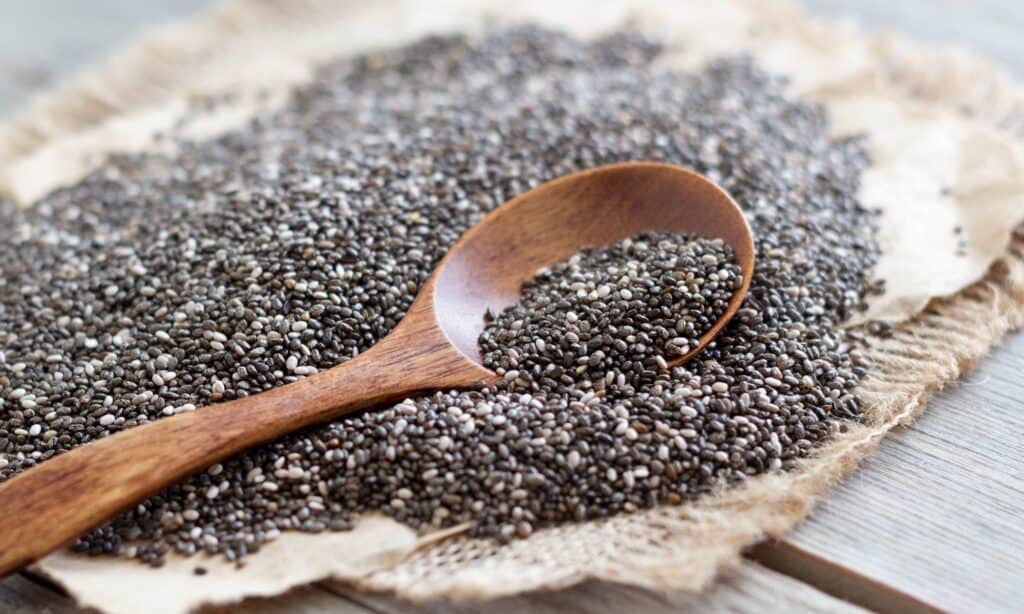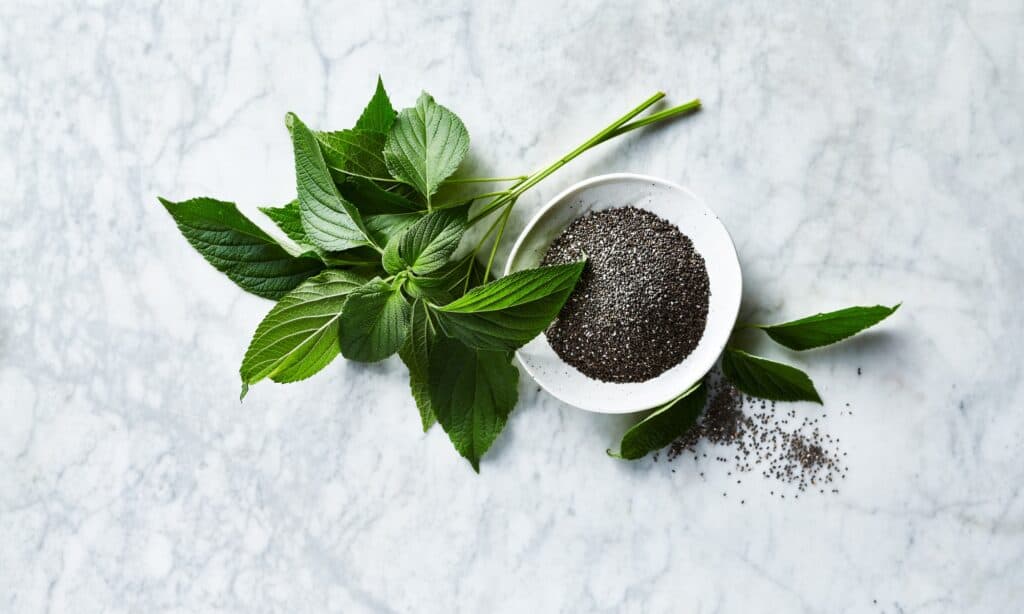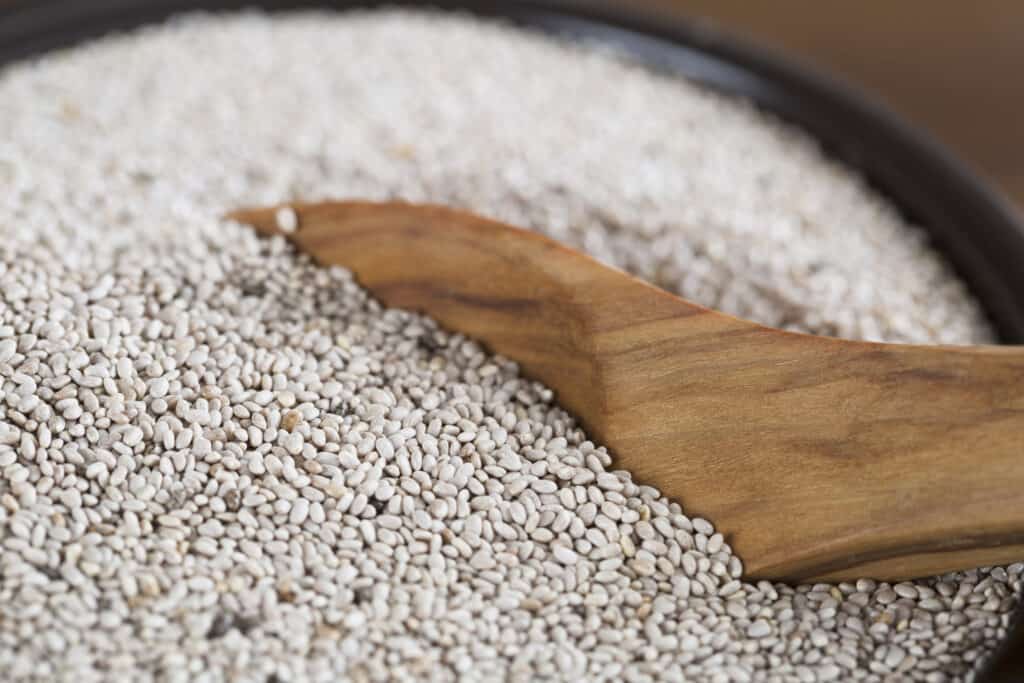Chia seeds are edible seeds that are widely hailed as ”superfoods” because of their health benefits. They are rich in nutrients and can be incorporated into a wide variety of recipes. The vast majority of chia seeds are black, although it is possible to get white ones too. But is there a difference between the two? Let’s discover everything you need to know about white vs. black chia seeds!
What Are Chia Seeds?

Chia seeds are edible seeds from the
Salvia hispanica(or chia) plant.
©iStock.com/Karisssa
First, we need to understand what chia seeds are. Chia seeds are edible seeds from the Salvia hispanica (or chia) plant. Salvia hispanica is a flowering plant from the Lamiaceae family group – which is better known as the mint family. It is native to Guatemala and Mexico, but it is widely grown and commercially produced across the United States and South America specifically for its seeds. The chia plant typically reaches around 5 feet 9 inches high and blooms with purple or white flowers, which develop on spikes at the end of each stem.
The chia seeds are small, flattened ovals – typically with a diameter of no more than 0.08 inches. The seeds can be either white or a mottled black or brown color. They are hydrophilic, which means that they absorb water, and when soaked, they can absorb up to twelve times their own weight.
Surprisingly, both black and white chia seeds are produced from exactly the same species of plant. However, the white seeds are caused by a recessive gene, whereas the black chia seeds are caused by a dominant gene. This leads to black chia seeds being produced more often than white chia seeds.
Benefits of Chia Seeds

Chia seeds are widely regarded as being one of the best sources of fiber in the entire world.
©iStock.com/barol16
Chia seeds are small but mighty. As well as being healthy, they are nutritious and can even be really beneficial too. For a start, they’re a great source of fiber – containing up to 40% in most cases. In fact, they are actually widely regarded as being one of the best sources of fiber in the entire world. This is one of the reasons that they are able to soak up so much water. Fiber aids the digestive system and helps to maintain gut health. It also helps you to feel full, which in turn can help with weight loss by curbing hunger and reducing food intake. They are high in protein too, which also contributes to the same factors.
Chia seeds also contain large amounts of calcium which is great for the bones – just one ounce of chia seeds can contain up to 18% of the RDA. Additionally, they contain minerals such as iron, copper, manganese, and phosphorus. Research also suggests that chia seeds can help to lower blood sugar levels and reduce blood pressure. However, that’s not to say that they can be used as replacements for medication – rather that there are plenty of benefits from eating them as part of a properly balanced diet.
What Are the Differences Between Black and White Chia Seeds?

The main difference between black and white chia seeds is their color.
©iStock.com/Michelle Lee Photography
The main difference between black and white chia seeds is their color! As we’ve just explained, they are both produced by exactly the same plant; they just look different because of genetics.
However, that’s not to say that they are entirely the same. There are actually some very small nutritional differences between the two, although these are impossible to properly distinguish between them because they are so minute and can vary depending on how and where the plant was grown. But we’ll explain them nonetheless.
Nutritional Differences
- Protein Content – On average, chia seeds contain 0.17 oz of protein per ounce of seeds. However, black chia seeds generally contain slightly more protein than their white counterparts do, although the actual difference is tiny.
- ALA Omega-3 Fatty Acid – Chia seeds typically contain 0.18 oz of omega-3 fatty acid per one ounce, but white chia seeds contain slightly less than black chia seeds.
White and Black Chia Seeds in Food
Despite the tiny nutritional differences between the two seeds, white and black chia seeds actually taste exactly the same. They can be used in a wide range of recipes and eaten in different ways.
Although chia seeds soak up liquid, they don’t need to be soaked to be eaten as they can be eaten raw too. In fact, there’s virtually nothing that you can’t do with them! Chia seeds can be used in cereals, smoothies, or yogurts. They can be sprinkled over food, or they can even be added to bread or tortilla recipes. Or, if you fancy something different, they can be ground down into a gel-like substance and used as an egg replacement for baking.
Are There Any Other Differences?

White chia seeds are generally classed as being rarer than black chia seeds.
©iStock.com/cheche22
There is only one other difference between black and white chia seeds – how much they cost! As white chia seeds do not develop on the Salvia hispanica plant as often as black chia seeds, they are not as widely available to buy. This means that they are generally classed as being rarer than black chia seeds, which in turn means that they are generally more expensive.
Conclusion
There is very little difference between white and black chia seeds, with the exception of their color. They both taste the same and have almost the same nutritional composition. In fact, quite often, they are marketed as being the same nutritionally because the difference is negligible. Therefore, you get the same benefits, no matter which color seeds you eat.
Up Next:
- Chia Seeds vs. Flax Seeds: What’s The Difference?
- Basil Seeds vs. Chia Seeds: What’s The Difference?
- Is Basil A Perennial Or Annual?
The photo featured at the top of this post is © iStock.com/Karisssa
Sources
- Ayoub's Dried Fruits and Nuts, Available here: https://ayoubs.ca/blogs/news/white-vs-black-chia-seeds-whats-the-difference
- Ayoub's Dried Fruits and Nuts, Available here: https://ayoubs.ca/blogs/news/health-benefits-of-chia-seeds
- Wikipedia, Available here: https://en.wikipedia.org/wiki/Chia_seed
- Healthline, Available here: https://www.healthline.com/nutrition/chia-seeds
Thank you for reading! Have some feedback for us? Contact the AZ Animals editorial team.







